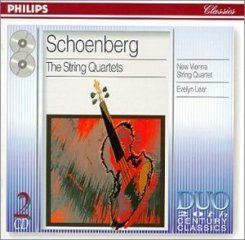Arnold Schönberg - Streichquartette I-IV (Complete String Quartets) [2000]
Arnold Schönberg - Streichquartette I-IV (Complete String Quartets) [2000]

CD1
Quartett d moll, Op. 7
[01] - I. Nicht zu rasch
[02] - II. Kraftig
[03] - III. Massig
[04] - IV. Massig
Streichquartett II fis-moll, op.10
[05] - I. Massig play
[06] - II. Sehr rasch
[07] - III. 'Litanei' langsam
[08] - IV. 'Entruckung' sehr langsam
CD2
Streichquartett III, op.30
[01] - I. Moderato
[02] - II. Adagio
[03] - III. Intermezzo, allegro moderato play
[04] - IV. Rondo, molto moderato
Streichquartett IV, op.37
[05] I. Allegro molto, energico
[06] II. Scherzo (comodo)
[07] III. Largo
[08] IV. Allegro
New Vienna String Quartet: Zlatko Topolski, Tomislav Sestak, Fritz Handschke, Wolfgang Herzer Evelyn Lear - soprano
The Austrian composer Arnold Schoenberg published four string quartets, distributed over his lifetime. These were the String Quartet No. 1 in D minor, Op. 7 (1905), String Quartet No. 2 in F sharp minor, Op. 10 (1908), String Quartet No. 3, Op. 30 (1927), and the String Quartet No. 4, Op. 37 (1936).
String Quartet No. 1
A large work consisting of one movement which lasts longer than 45 minutes, Schoenberg's first string quartet was his first assured masterpiece, and it was the real beginning of his reputation as a composer. Begun in the summer of 1904 and completed in September 1905, this string quartet is remarkable for its density and intensity of orchestration with only four instruments. Unlike his later works, this work is tonal, bearing the key of D minor, though it stretches this to its limit with the thoroughly extended tonality of late Romantic music, such as the quartal harmony pictured at right. It also carries a small collection of themes which appear again and again in many different guises. Besides his extension of tonality and tight motivic structure, Schoenberg makes use of another innovation, which he called "musical prose."
According to Schoenberg, when he showed the score to Gustav Mahler, the composer exclaimed: "I have conducted the most difficult scores of Wagner; I have written complicated music myself in scores of up to thirty staves and more; yet here is a score of not more than four staves, and I am unable to read them."
String Quartet No. 2
This work in four movements was written during a very emotional time in Schoenberg's life. Though it bears the dedication "to my wife", it was written during Mathilde Schoenberg's affair with their friend and neighbour, artist Richard Gerstl, in 1908. Previous dedicatees are guessed at to have been either Arnold Rosé, the founder of the Rosé quartet (who performed Schoenberg's string quartets) or Gustav Mahler, a good friend of Schoenberg.
The third and fourth movements are quite unusual for a string quartet, as they also include a soprano singer, Marie Gutheil - Schoder, using poetry written by Stefan George. "I was inspired by poems of Stefan George, the German poet, to compose music to some of his poems and, surprisingly, without any expectation on my part, these songs showed a style quite different from everything I had written before." - Arnold Schoenberg (1937)
String Quartet No. 3
Arnold Schoenberg's third string quartet dates from 1927, after he had worked out the basic principles of his twelve-tone technique. Though the work is serial, he discouraged attempts to follow the transformations of the pitch series aurally. The themes of this work seem to consist mainly of rhythmic patterns rather than pitch, which are reused in variation just as in Classical music.[citation needed] Indeed, Schoenberg had followed the "fundamental classicistic procedure" by modeling this work on Schubert's String Quartet in A minor, op. 29, without intending in any way to recall Schubert's composition. There is evidence that Schoenberg regarded his 12-tone sets—independent of rhythm and register—as motivic in the commonly understood sense, and this has been demonstrated with particular reference to the second movement of this quartet.
The piece was commissioned by Elizabeth Sprague Coolidge on March 2, 1927, though the work had already been completed by this time, and its première was given in Vienna later that year on September 19 by the Kolisch Quartet.
String Quartet No. 4
The fourth string quartet of 1936 is very much representative of Schoenberg's late style. The work is dodecaphonic like the third string quartet, though in this quartet the focus is much more melodic rather than rhythmic. The first movement is in an adapted sonata form. J. Peter Burkholder has suggested that in this movement Schoenberg's choice of the different forms of the 12-note row function in a manner analogous to the different tonal areas explored in a sonata form that is written in traditional tonality. The slow movement opens with a long unison recitative in all four instruments while the finale has the character of a march, similar to the last movement of Schoenberg's Violin Concerto written about the same time.
This work, like the third quartet, was commissioned by Elizabeth Sprague Coolidge, and was completed on July 26, 1936. Its first performance was given January 8, 1937 in Los Angeles by the Kolisch Quartet.
download: uploaded yandex 4shared mediafire solidfiles mega zalivalka filecloudio anonfiles oboom
Last Updated (Saturday, 26 April 2014 09:46)
